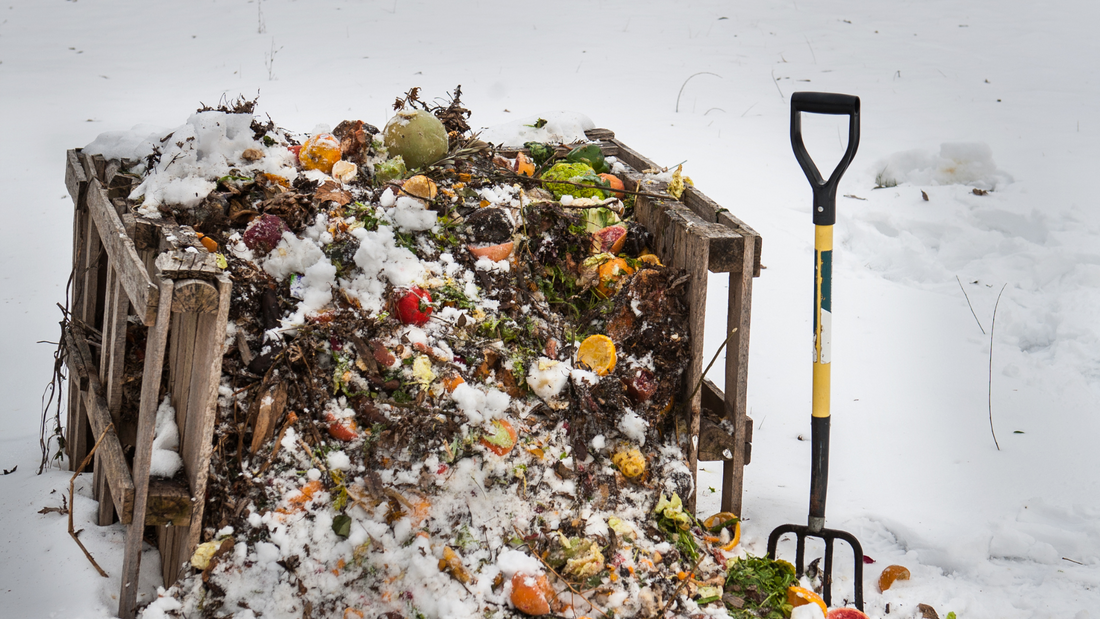
How Winter Composting Can Benefit Your Spring Garden: Insider Tips
As winter blankets the garden in frost, it might seem like the perfect time to tuck away your gardening ambitions. However, what if I told you that the colder months hold a secret key to a more vibrant spring garden? Winter composting, often overlooked, is a game-changing practice that savvy gardeners employ to enrich their soil and set the stage for a burst of life when the frost retreats.
In this guide, we'll delve into the world of winter composting, exploring the benefits and sharing insider tips on how to make the most of this often underestimated practice. So, grab your gardening gloves, dust off that compost bin, and join us on a journey to uncover the hidden potential that winter holds for your garden. It's time to learn how to turn the chill into an ally for a flourishing spring garden.
Understanding Winter Composting
Winter composting involves the continuation of composting activities even when the temperatures drop. It is like summer composting but in a slow process. It's not just a matter of convenience; it's a strategic move that aligns with nature's rhythms. The decomposition process might slow down in winter, but it doesn't come to a complete standstill. Microorganisms continue their work, albeit at a more leisurely pace, breaking down organic matter and enriching your compost pile.
The Benefits of Winter Composting
Enhanced Soil Structure and Fertility
One of the primary advantages of winter composting is the improvement it brings to soil structure and fertility. The slow decomposition during winter allows for a more thorough breakdown of materials, resulting in nutrient-rich compost. Come spring, your garden soil will be teeming with life, providing an ideal environment for plant roots to flourish.
Weed Suppression
Winter composting can be a secret weapon against weeds. By covering your garden beds with a layer of compost during the freezing months, you create a natural barrier that inhibits weed growth. This means less time spent battling unwanted vegetation and more time enjoying your garden.
Temperature Regulation
Winter composting also acts as a natural insulator for your soil. The compost layer helps regulate soil temperature, preventing it from extreme fluctuations. This is particularly beneficial for plants with delicate roots that might otherwise struggle in the unpredictable winter weather.
Continuous Nutrient Supply
Composting in winter ensures a steady supply of nutrients for your soil. As organic matter breaks down, it releases essential nutrients like nitrogen, phosphorus, and potassium, enriching the soil and providing a nourishing base for your plants in the spring.
Moisture Retention
Winter composting helps improve soil structure, enhancing its ability to retain moisture. This is especially beneficial in regions where winter precipitation is low, as the composted soil can better retain water for your plants during the drier spring months.
Early Planting Opportunities
Composting throughout the winter allows you to have nutrient-rich soil ready for early spring planting. Your garden beds will be well-prepared, giving you a head start on the growing season and potentially leading to healthier and more productive plants.
Waste Reduction
Winter composting provides a sustainable way to manage kitchen and garden waste during the colder months. Instead of sending organic matter to the landfill, you can recycle it into valuable compost that benefits your garden.
Setting Up Your Winter Compost Bin
Setting up a winter compost bin requires a bit of strategic planning to ensure that your composting efforts thrive even in the chilliest temperatures. Whether you're a seasoned composter or a novice gardener, follow these steps to establish a winter compost bin that sets the stage for a flourishing spring garden.
1. Choosing the Right Location
Selecting an appropriate location is the first step in setting up your winter compost bin. Aim for a spot that receives some sunlight, as this helps maintain a slightly warmer environment for the composting process. Additionally, consider placing the composting bin in an area shielded from harsh winter winds to further protect it from extreme weather conditions.
2. Winter-Resistant Compost Bins or Compost Tumblers
Consider investing in a winter-resistant compost bin designed to withstand colder temperatures. These bins often come with features like double-walled insulation, which helps maintain a more stable internal temperature. While not a necessity, a winter-resistant bin can make the composting process more efficient during the colder months.
A Compost Tumbler is a handy tool for composting, it is perfect for composting your food waste. You don't need to aerate the compost with a garden fork, unlike traditional compost piles. Just load it up with your organic materials, close the sliding door, and use the convenient built-in hand holds to give it a turn every couple of days and see how it produces finished compost.
3. Adjusting the Carbon-to-Nitrogen Ratio
Achieving the right balance of carbon and nitrogen-rich materials is crucial for successful composting in the winter. In colder temperatures, microorganisms responsible for decomposition work more efficiently when there's a higher concentration of nitrogen. Add kitchen scraps, such as fruit and vegetable peels, coffee grounds, and eggshells, to boost the nitrogen levels in your compost pile during the winter months.
4. Covering Your Winter Compost Piles
Think of your compost pile as needing a warm winter blanket. Cover it with a tarp or a thick layer of straw to retain heat and moisture. This protective covering not only shields your large compost pile from the harsh elements but also prevents it from becoming too soggy during winter rains. A well-covered compost pile is more likely to maintain the optimal conditions for decomposition.
5. Winter-Friendly Compost Materials
While your regular compost materials may still break down during winter, consider adjusting your mix to accommodate the colder temperatures. Focus on green and brown materials that decompose more easily in the cold, such as smaller pieces of organic matter. Shred or chop materials like leaves, grass clippings, cardboard, newspaper or other food scraps and waste to facilitate quicker decomposition during winter.
6. Monitoring Moisture Levels
Winter composting comes with its own set of challenges, including moisture management. Too much moisture can slow down the decomposition process or create a waterlogged environment. Regularly check the moisture levels in your compost pile and adjust as needed. If your traditional compost pile appears too dry, add some water; if it's too wet, mix in dry materials like straw or leaves.
Winter Composting Challenges
Slow Decomposition of Compost Pile
Winter composting does come with its challenges, and the most prominent one is the slower decomposition rate. Gardeners need to be patient and understand that the process might not be as rapid as during the warmer months.
Moisture Management
Excessive moisture can impede the composting process in winter. Regularly check the moisture levels and adjust as needed, ensuring a balance that promotes decomposition without creating a waterlogged environment.
Winter Composting Tips From The Pros
Introduce Heat Sources
For those in extremely cold climates, consider introducing heat sources like composting heaters to keep the microbial activity in your compost pile steady. This extra warmth can make a significant difference in maintaining an optimal composting environment.
Use Insulating Materials
Insulating your compost pile with materials like straw or leaves can provide an extra layer of protection against the biting winter cold. This technique is particularly useful in regions where temperatures plummet below freezing.
Composting Indoors
If outdoor composting seems challenging in winter, consider bringing the process indoors. Utilize indoor compost bins or worm composting systems, often referred to as vermicomposting. These systems thrive in controlled indoor environments, allowing you to continue composting without being at the mercy of freezing temperatures.
Bokashi Composting
Bokashi composting is a unique method that involves fermenting organic waste using beneficial microorganisms. Even in winter, Bokashi bins can be employed indoors, providing a way to compost kitchen scraps without the need for outdoor exposure. The fermented material can later be mixed into the outdoor compost pile or buried directly in the garden.
Harvesting Your Winter Compost for Spring
As the cold days of winter gradually yield to the warmer embrace of spring, it's time to reap the rewards of your winter composting efforts. Harvesting your winter compost is a pivotal step in transitioning from the dormancy of winter to the vibrancy of the growing season. In this guide, we'll walk you through the process of extracting the black gold you've cultivated during the colder months, unlocking the potential it holds for a flourishing spring garden.
1. Assessing Readiness
Before diving into the harvest, it's crucial to ensure that your winter compost is fully cooked. Signs of readiness include a dark, crumbly texture and an earthy, pleasant smell. If your compost still resembles its original materials or has a sour odor, give it a bit more time to mature.
2. Choosing the Right Tools
Harvesting compost doesn't require fancy equipment, but having the right tools can make the process smoother. Grab a sturdy garden fork or shovel to turn and loosen the compost, along with a wheelbarrow or a compost bin for collecting the finished product.
3. Clearing the Top Layer
Start by removing any covering or insulation from the top layer of your compost pile. Whether it's a tarp, straw, or leaves, set them aside for later use in your garden or for covering the fresh compost.
4. Turning the Pile
Using your garden fork or shovel, turn the compost pile. This aerates the material, introducing oxygen and accelerating the decomposition process. Pay attention to the center of the pile, as this is where decomposition is likely most active.
5. Harvesting the Good Stuff
As you turn the compost, sift through the material and extract the finished compost. Aim for the well-decomposed, dark, crumbly sections. Leave any unprocessed or partially decomposed materials in the pile for further maturation.
6. Storing or Using Your Winter Compost
Once harvested, you have options for using or storing your winter compost. Spread it directly on your garden beds, incorporating it into the topsoil. Alternatively, store it in a covered bin or container for future use. Your winter compost is a nutrient powerhouse, so use it where your plants need it most.
7. Restarting the Composting Cycle: Preparing for the Next Season
With your winter compost harvested, consider restarting the composting cycle. Begin collecting fresh kitchen scraps, yard waste, and other compostable materials. Layer them onto the remaining compost pile, setting the stage for another round of decomposition and a new batch of nutrient-rich compost.
Conclusion
As we wrap up our chat about winter composting and its perks for your spring garden, let's sum it up in. Winter composting is like a backstage crew working silently to make your garden shine when the curtain rises in spring. Your garden soil gets a power boost, turning into a cozy home for plant roots to stretch and thrive.
As you gear up to set up your winter compost bin, remember: it's all about balance. Find the right mix of your kitchen waste and scraps, cover your compost pile like you're tucking it in for a nap, and be patient. It's like sending your garden a love letter – it might take a while, but the response is heartwarming.
Think of it as your garden's winter magic trick, and you're the magician. Happy composting, and here's to a spring garden that'll make your efforts shine!
